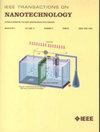Preparation of Nanofibrous Membranes Containing Carbon Dots Composited With TiO2 Photocatalyst and Their Removal Rate of Methylene Blue Under Visible Light
IF 2.1
4区 工程技术
Q3 ENGINEERING, ELECTRICAL & ELECTRONIC
引用次数: 0
Abstract
As the industrialization is improving by way of science and technology in society, water pollution has become increasingly serious. Non-degradable organic matter exists in wastewater, which causes environmental deterioration. In order to solve this problem, we select titanium dioxide (TiO2) as the photocatalyst material with high activity, chemical stability and low cost. However, pure TiO2 has a large band gap (3.2 eV) and can only be activated under ultraviolet (UV) light. Therefore, TiO2 has to be modified to fit our requirement. Carbon dots (CDs) have up-conversion and down-conversion photoluminescence and inhibit the recombination of electron-hole pairs, Adding CDs can reduce the band gap width of TiO2, and increase the absorption of visible light significantly, thereby improving photocatalytic efficiency. We use citric acid as the carbon source and urea as the nitrogen source to prepare CDs by using the hydrothermal method, and prepare the CDs/TiO2 composite photocatalyst through the sol-gel method. The CDs/TiO2 composite photocatalyst shows stable and efficient photocatalytic performance for removal of methylene blue (MB), with a removal rate of 95.34%. In order to reuse the CDs/TiO2 composite photocatalyst powder, we use electrospinning technology to combine CDs/TiO2 composite photocatalyst with nylon 6,6 nanofibrous membranes. After three cycle tests, we confirm that it is recyclable and practical, and its removal rate is also increased to 99.39%.TiO2光催化剂复合碳点纳米纤维膜的制备及可见光下对亚甲基蓝的去除率
随着社会工业化程度的不断提高,水污染问题日益严重。废水中存在不可降解的有机物,造成环境恶化。为了解决这一问题,我们选择了活性高、化学稳定性好、成本低的二氧化钛(TiO2)作为光催化剂材料。然而,纯TiO2具有较大的带隙(3.2 eV),只能在紫外光下被激活。因此,TiO2必须经过修饰以满足我们的要求。碳点(CDs)具有上转换和下转换的光致发光特性,并抑制电子-空穴对的复合,添加CDs可以减小TiO2的带隙宽度,显著增加对可见光的吸收,从而提高光催化效率。我们以柠檬酸为碳源,尿素为氮源,采用水热法制备CDs,并通过溶胶-凝胶法制备CDs/TiO2复合光催化剂。CDs/TiO2复合光催化剂对亚甲基蓝(MB)的去除率达到95.34%,表现出稳定高效的光催化性能。为了重复利用CDs/TiO2复合光催化剂粉末,我们采用静电纺丝技术将CDs/TiO2复合光催化剂与尼龙6,6纳米纤维膜结合。经过三次循环试验,确认其可回收性和实用性,去除率也提高到99.39%。
本文章由计算机程序翻译,如有差异,请以英文原文为准。
求助全文
约1分钟内获得全文
求助全文
来源期刊

IEEE Transactions on Nanotechnology
工程技术-材料科学:综合
CiteScore
4.80
自引率
8.30%
发文量
74
审稿时长
8.3 months
期刊介绍:
The IEEE Transactions on Nanotechnology is devoted to the publication of manuscripts of archival value in the general area of nanotechnology, which is rapidly emerging as one of the fastest growing and most promising new technological developments for the next generation and beyond.
 求助内容:
求助内容: 应助结果提醒方式:
应助结果提醒方式:


